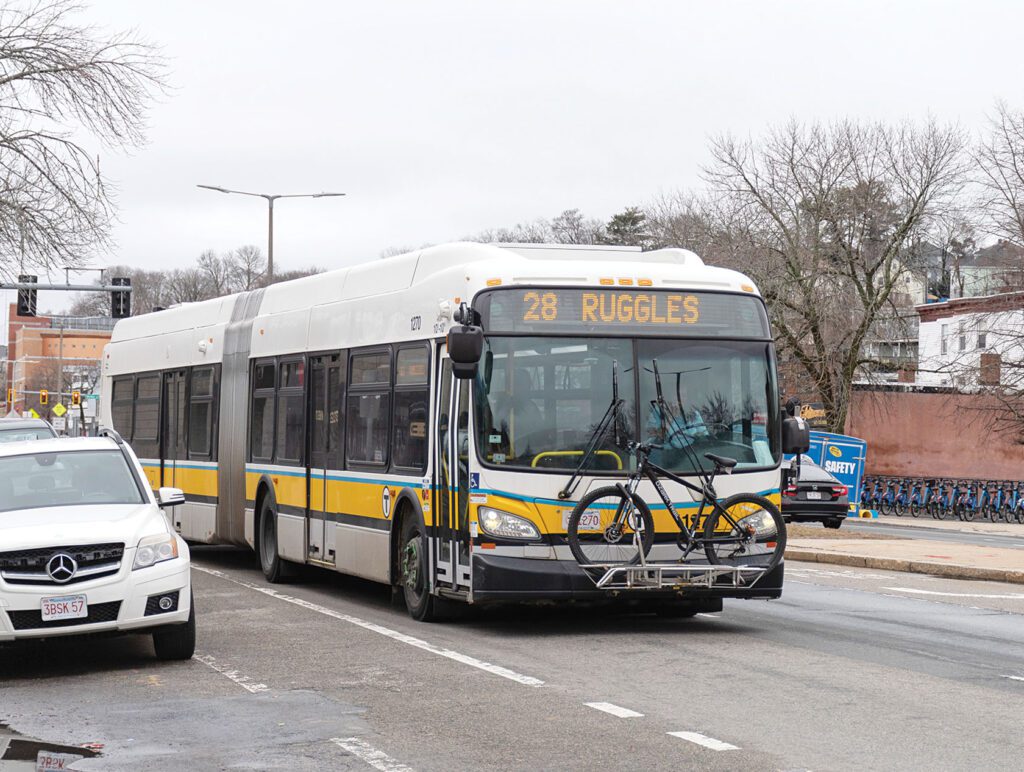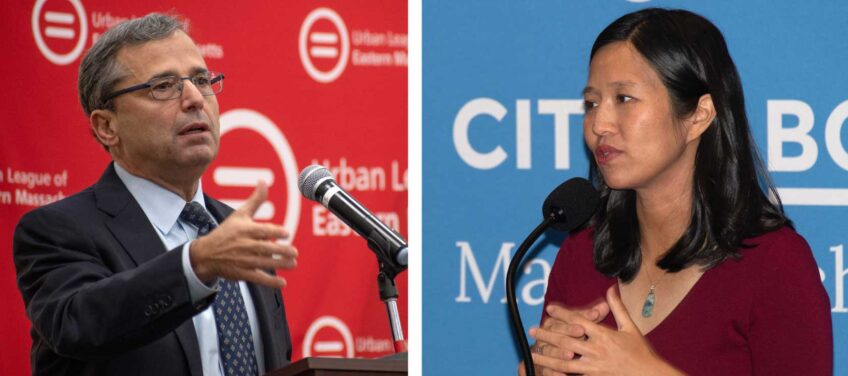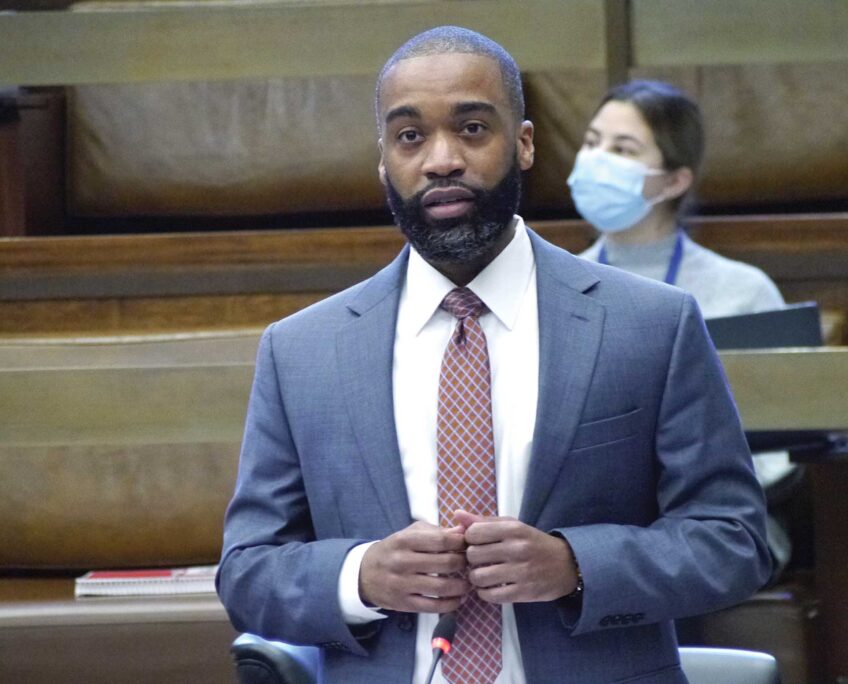Blue Hill Avenue redesign receives mixed reviews
City proposal would add center bus lane, maintenance and beautification efforts

On a misty morning in Mattapan Square, Fatima Ali-Salaam stops to submit a picture of a toppled steel trash can, its contents spilling out across the sidewalk, to Boston 311, the city’s problem-reporting app and hotline. Five minutes down Blue Hill Avenue, she reports a trash heap including a large, torn-up mattress. At Blue Hill Avenue and Morton Street, she keeps an eye on a crossing signal that doesn’t change for the nearly 15 minutes she waits.
The stops are part of an almost-nine-mile walk from one end of Blue Hill Avenue to the other and back that Ali-Salaam, who heads the Greater Mattapan Neighborhood Council, does every Sunday morning to take the pulse on the roadway, which serves as a major artery for Mattapan, Dorchester and Roxbury toward the center of the city. Between piles of trash, uneven pavement and out-of-order crossing signals, her unofficial weekly audit tends not to come back empty-handed.
“We need change. I don’t think anybody would think that we don’t,” Ali-Salaam said.
The administration of Mayor Michelle Wu is planning to use federal funding for a $44 million overhaul of the roadway, with a focus on updated bus and pedestrian infrastructure. The work is slated to begin in 2026.
The proposed transformation of the roadway would revolve around center-running bus lanes from Mattapan Square to Warren Street that could speed up travel times for the more than 37,000 riders who use bus routes along Blue Hill Avenue daily, making it the travel corridor with the highest ridership in the MBTA. That key piece of the project, and one of the only specifics that has been so far announced, has received mixed reviews from community members and leaders.

On Blue Hill Avenue, one of the major transportation route in Mattapan, Dorchester and Roxbury, the city is planning $44 million worth of work to add a center-running bus lane and do general maintenance and beautification work, starting in 2026. BANNER PHOTO
The plan, announced Feb. 28, comes after two years of specific community engagement efforts and more than a decade of conversations about how to renovate the thoroughfare. City officials say they plan to target safety and efficient transportation.
Specific details around the work remain to be determined as the city continues to engage the community to develop plans that could vary block by block. Those efforts will last about two years, with a final plan slated to be released at the end of 2025.
In the short term, as the city develops concrete plans, it will start with beautification and repair efforts to address long-term disinvestment in the area.
Since Ali-Salaam started her weekly walks almost five years ago, she said conditions along the road have only declined, with no significant maintenance or improvement efforts. The city’s work would include things like repairing damaged sections of sidewalk and roadway, refreshing crosswalk and road markings, improving streetlighting and installing speed humps in nearby neighborhood roadways.
Louis Elisa, president of the Garrison Trotter Neighborhood Association, said that work to repair and maintain the area is long overdue, but doesn’t see a benefit for residents of Boston, especially its Black communities.
“There’s no reason they can’t fix up Blue Hill Avenue without putting in a center bus line,” said Elisa, whose neighborhood association borders Blue Hill Avenue between Warren Street and Seaver Street.
He said he will be glad to see the better tree coverage the project promises, along with curb cutouts and better access for disabled community members, but worries the center-running bus lanes will cause major disruption in the communities that line Blue Hill Avenue. That change, he said, would complicate traffic and access to schools and other locations. Business operations could be impacted if the project takes away already limited parking spots — along the roadway, cars are often double-parked and sometimes triple-parked. On Sunday mornings, outside big churches like the Morning Star Baptist Church in Mattapan, cars spill out from the parking lot, double-park a block in either direction and sit on the cement median.
Elisa said he sees the proposed work as a boon to communities south of the city whose residents drive into Boston, as well as construction industries, but not for the nearby neighborhoods themselves.
“It’s the spine, and you can’t clog up the spine without affecting the various veins and arteries,” he said.
But the center bus lane also brings an opportunity to shift what is primarily a car-focused roadway into a route that takes a more balanced consideration of different modes of transportation, said Makayla Comas, senior manager of community engagement at the transit advocacy group Livable Streets.
“It’s the manifestation of equalizing the road space,” said Comas, who helped collect perspectives from bus riders along Blue Hill Avenue as the city ran a two-year community engagement effort.
According to the MBTA, bus riders on Blue Hill Avenue collectively lose an estimated 3,000 hours in traffic, and across the system, Black bus riders tend to spend 64 more hours on average on buses than their white counterparts.
Emmanuell De Barros, director of development and community engagement at the Roxbury-based Alternatives for Community and Environment (ACE), said he views the target audience of the Blue Hill Avenue work as transit riders, who could see travel times drop by over 30 minutes, according to city estimates. ACE runs the T Riders Union, which is dedicated to improving service for public transit users, especially low-income riders and riders of color.
Ed Gaskin, who leads Greater Grove Hall Main Streets, said that in Grove Hall, the project might present the new opportunities to expand green space through improved medians.
“We saw the green median as a piece of green infrastructure that can have a lot of benefit to the community,” he said in an interview.
Greater Grove Hall Main Streets has been engaged in trying to improve Blue Hill Avenue medians in the commercial district for years. In the summer of 2017, the organization identified work that could be done to beautify the space.
In Grove Hall, the dividers that separate traffic have patchy grass and limited landscaping, while the Seaport District has medians that are a lush green and decorated with public art, Gaskin noted.
That Greater Grove Hall Green Medians project, which started as an initiative to beautify these spaces, would also cool and limit the urban heat island effects in the summer and help manage stormwater if implemented, Gaskin said.
Many of these goals are included in the city’s proposed work, which would include planting new trees to help address heat impacts and install green infrastructure to help address storm flooding, absorb solar energy and reduce carbon emissions in the area.
Gaskin said he’s aware of community members’ objections to a center-running bus lane, but his Main Streets organization didn’t want to get involved with that conversation, opting instead to focus on how the Blue Hill Avenue project can help bring better medians and green spaces.
The center-running bus lane would be the second in Boston, after the city installed a dedicated center bus lane along Columbus Avenue, where red-marked lanes are set aside for buses only and platforms on either side offer improved bus stops and shelters.
A 2023 report from the city found that the Columbus Avenue center bus lane hastened travel times for bus riders by three or four minutes during rush hour. As part of that report, a survey found that about 25% of respondents rode the bus more frequently after the bus lanes were installed.
According that report, some nearby neighborhood streets have seen increases in traffic — a concern Elisa has for the impact of the Blue Hill Avenue project if implemented — but around Columbus Avenue, the city found that the increase in neighborhood traffic varied widely.
For Ali-Salaam, the work that needs to be done on Blue Hill Avenue goes beyond adding a bus lane. She said the general maintenance and beautification work the city is promising is key, but the area also needs more economic revitalization. Much of that, she said, she didn’t see come to Columbus Avenue when the center-running lane was installed.
“I really hope we get more than what was done on Columbus Avenue,” she said. “I really hope we get more than a red stripe on the road.”






